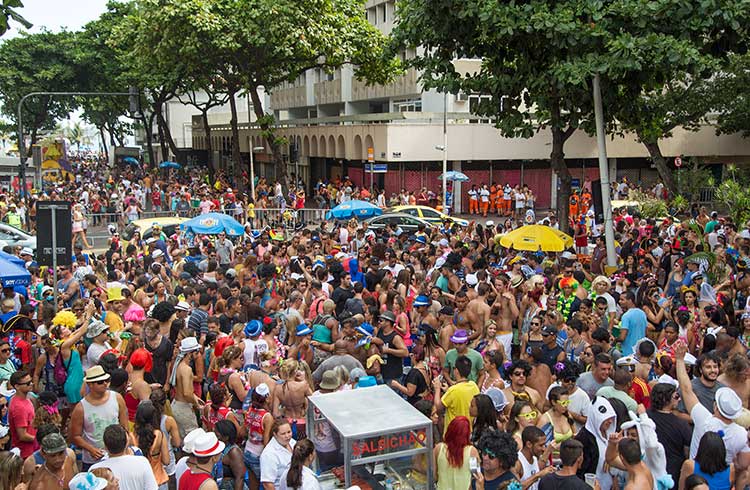Staying Safe in Rio: 8 Essential Tips for Travelers
Despite growing concern about safety in Rio, travelers continue to flock to this incredible seaside city. Here's everything you need to know to stay safe.
 Photo © Photo by Raphael Nogueira on Unsplash
Photo © Photo by Raphael Nogueira on Unsplash
The wealth of Ipanema and Copacabana are dramatically juxtaposed to the crowded poverty in the city's favelas, which often results in violent clashes and crimes. no wonder there is a growing concern for Rios reputation.
Between the surf breaks, Sugarloaf Mountain and Mount Corcovado, the charming city of Rio is full of architectural, cultural and festive experiences. Keep your wits about you and your belongings out of sight, and you'll have nothing but pleasant surprises in Rio.
Doing the Rounds in Rio
Heading to the top of Christ the Redeemer is right at the top of most visitors itineraries. There are many ways to reach the top of the statue's perch at Corcovado Mountain. The easiest but most expensive is to an organised tour group which will pick you up from your accommodation, and these often include a trip to Sugarloaf Mountain as well. If you want to spend more time at either of these locations, the best way to do it is independently.
The alternatives are a taxi, tourist van or the funicular (cog train), which can all be found at the train station on Rua Cosme Velho at the base of the hill.
You may be able to negotiate a flat rate with a cab driver, but if you're looking for a budget option, try to jump onboard a half-full van that is about to set off. The driver will want to maximise his return on the round trip, so extra passengers are a bonus.
If you want to take your time, the best bet is to take the tram up. The return ticket includes the price for the entrance fee.
There is a walking trail, but robberies are common along the track, and it does take about two hours to reach the top. If you do choose to hike to the top, always go in a group and don't take anything valuable with you.
See the Sunset at Sugarloaf Mountain
Rio's bizarre lumpy landscape is best seen at sunset from high above.
During summer the crowds gather on Ipanema beach almost every evening to watch the sun sink between the Two Brothers Mountains. You'll often hear applause over the surf as the last rays fade behind the horizon. But the best place to capture the daily spectacle is from Sugarloaf Mountain. A cable car ride to the top will give you an almost unobscured 360-degree view of the city.
Unfortunately, as one of Rio's most popular tourist destinations, it's not a very well kept secret. There are long waits for the cable car in the early evening. The trip takes two legs as well, stopping at the smaller Urca Hill on the way, so you'll have to queue twice.
A less manic way to handle it is to head up a little earlier to avoid the lines, take in the daytime view and have a drink at the hilltop bar while you wait for the sun to drop.
Like Corcovado, it is possible to walk up the back of Sugar Loaf. The trail begins near the cable car station but is obscured by a cleverly placed pillar. It's quite a strenuous climb, however, and if you decide you don't want to repeat it on the way down you'll be dismayed to find out you can't buy cable car tickets on the summit. Buy yourself a one-way ticket before setting off, even if you're planning to walk back down.
If you hang around for the last cable car down (generally 8.40pm but check signs) be aware that taxis may be in short supply by the time you reach the bottom. Buses aren't recommended after dark, especially if you have to make a few changes or will be waiting at the bus stop for a while, so maybe forsake the last few snaps to make sure you grab a cab.
Favelas Take the Rap
Rio has a network of favelas, or shantytowns, scattered throughout the city. The residents of these impoverished areas are blamed for much of the city's crime. However, the majority of the favelas residents are law-abiding citizens, with a few bad eggs giving the rest a bad name.
In fact, the favelas themselves are quite safe. Iron-fisted drug lords prevent crime in their territory and the surrounding districts, meaning a visit to these vibrant communities should be a big to-do on your list.
Beaches in Rio
The beach is where Rio's great division ends. People from every end of the city are sprinkled over the sparkling white sand, tossed together in the surf. Copacabana is the most renowned, but the local favourites Ipanema and Leblon are growing in popularity among tourists. All are incredibly crowded during high season but somehow there's always space available, whichever you choose.
The crowds mean a lot of petty crime goes unnoticed, so keep a watchful eye on your valuables. Most thefts on the beach will occur behind your back or while you're distracted but some are more brazen. Some travellers report bands of children rushing onto the beach and grabbing everything they can before disappearing into the streets, while jewellery and cameras have been ripped off tourists in broad daylight as well.
But with so much on offer at the beach, there's little need to bring anything more than a towel and the smallest swimwear you can find. If you chose to hire a chair and umbrella from one of the many stalls, they'll generally offer to bring drinks to you for the rest of the day, although you may pay a slightly higher price.
If you're out for a bargain, there's a plethora of hawkers wandering the beach, selling everything from sunglasses to chicken hearts. If you felt so inclined you could plant yourself in your seat and admire Brazil's best bodies from sunrise to sunset.
Chances are the heat will get to you at some stage however and you'll want to cool off in the water. If you're in a group, have someone stay and watch your valuables. Otherwise you can ask someone nearby to keep an eye on them, the Cariocas (Rio's residents) hate crime as much as you and will be happy to oblige. One trick is to hook the straps of your bag around your umbrella, preventing a quick swipe, although this is far from foolproof.
The water itself isn't particularly clean, especially around the channel at Leblon, so try to avoid swallowing any.
Be careful in the surf as well. There are lifeguards on duty but the sheer mass of people in the water means you could be drowning in plain sight and very few people would notice.
Signal Towers
Locals will tell you the numbered lifeguard towers (postos) on Ipanema serve a secondary function as well, dividing the beach into demographics.
The surfers congregate near Arpoador at Posto 7, the young and the beautiful head to Posto 9, family groups dominate Posto 11 in Leblon, while the area between Posto 8 and 9 is a famously gay-friendly zone. Each tower seems to have its own reputation but in our experience, there is little obvious difference between them.
Girls should note that although Brazilians are comfortable with bikinis apparently crafted from dental floss, topless sunbathing is not allowed.
The beaches are best avoided at night, with wandering tourists a target for robberies. But if you do head down there beware of locals offering you drugs. They are usually working in concert with a cop nearby to extort a bribe from you.
Be Careful at Night
The parade of flesh on Rio's beaches might have you on the prowl at night, but be careful if you suddenly come across an overly friendly local. You may think you've found your own Girl (or boy) From Ipanema, only to wake up hours later, the victim of a sleeping draft known as Boa Noite Cinderela (Good Night Cinderella). It may sound like a fairy tale but there are numerous reports of the knockout drug being used to rob unsuspecting victims.
It's best to head out with a buddy so you can keep an eye on each other. Never let your drink out of your sight and don't accept drinks bought by strangers.
In some cases, the victims were even drugged in their hotel rooms so don't let your guard down once you get home.
If your newfound friend seems overly interested in where you're staying, they may be organising a buddy to help clean out your belongings. Try not to be specific about your accommodation, especially if it's an expensive hotel, as this will make you a more inviting target.
Getting Around Rio
Walking around Rio's main streets, especially near the beaches, is perfectly safe during the day, despite the city's reputation. However, just because you're in a wealthy or touristy neighbourhood doesn't mean you're safe to wander at night. In fact, these areas are specifically targeted by criminals.
The safest way to get from place to place in Rio is by registered radio taxi. Ask someone at your accommodation to order one for you, or duck into a nearby hotel if you're out an about. The city's yellow cabs are a good option if you're in a hurry and are a little cheaper as well. Try to find a cab with a meter or prearrange a price before your trip. There's no shortage of cars so you can afford to be picky. Always check the cab's front window for a license sticker and take a note of the company's name and number on the side. Never get into an unlicensed cab.
Take care when paying your driver as well. One known scam involves the driver quickly grabbing a $R50 note, deftly swapping it with a $R5 before accusing you of underpaying. Take care when you're selecting your notes and ask them to turn on the overhead light if it's dark. If you're sure you paid the right amount, don't let them intimidate you, although you don't want to push your luck too far.
Buses in Rio are cheap, frequent and quite safe during the day. Because of the city's long, skinny shape it's difficult to go too far out of your way, even if you jump on the wrong bus. Be very careful of pickpockets, however. One traveller had his wallet taken from a zipped-up pocket inside his bag by a couple of girls working in concert.
Steer clear of buses at night, especially if you have to change lines. Bus stops are a known target for muggings.
Managing the Worst Case Scenario
Despite all its charm, Rio's reputation for crime is well-deserved and no matter how careful you are to avoid it, there's a chance that you'll end up having a bad experience. However, there are several ways to make sure one bad experience doesn't ruin your trip.
Don't make yourself a target. Rio's dress code is very casual so don't overdo it. Shorts and thongs (both kinds) are the rule on the street. Leave the iPod and any expensive jewellery at home.
Take a taxi, even for short trips, and stick to well-lit streets if you're trying to find one.
If you're in a crowded place, be aware of your belongings. At the Lapa street parties or during Carnival, groups of kids often swarm tourists. If this happens, keep your hands in your pockets or hold your bag to your chest.
A dummy wallet with a few reais in it can make the thief feel like they've snagged something while saving you the hassle of cancelling cards.
This technique can also work if you're unlucky enough to be the victim of a mugging. Whatever you do, don't struggle. Hand over your things and try hard not to provoke your attackers. Losing your camera might be upsetting, but losing a litre of blood will be far worse.
Related articles
Simple and flexible travel insurance
You can buy at home or while traveling, and claim online from anywhere in the world. With 150+ adventure activities covered and 24/7 emergency assistance.
Get a quote


3 Comments